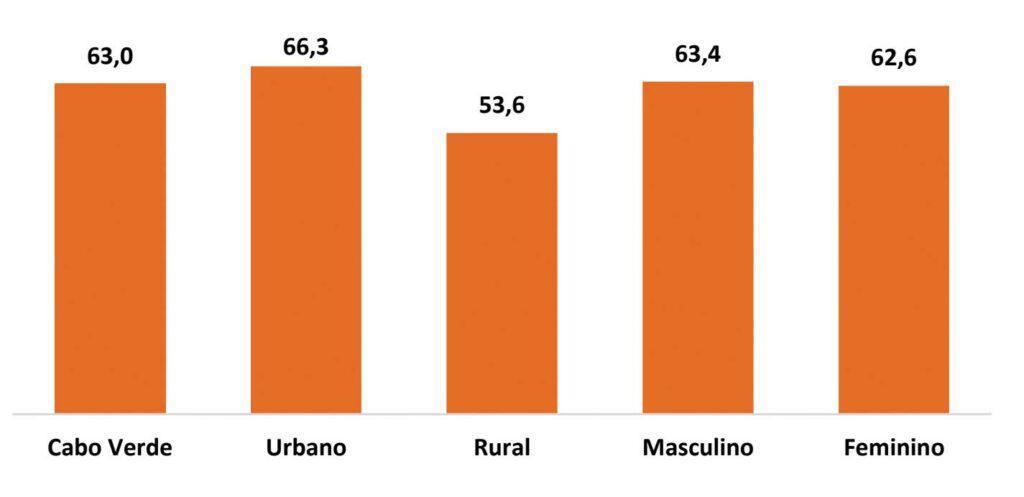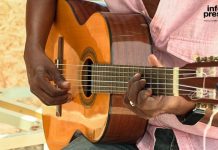PerGisela Coelho
Africa-Press – Cape verde. Data from the 2022 Continuous Multiobjective Survey by the National Institute of Statistics (INE) revealed this Wednesday, 7, show that the overwhelming majority of Cape Verdeans (98.1%) aged 10 or more use their cell phones to access the internet . The data are contained in the module on Communication and Information Technologies (ICT) and also reveal that the vast majority of internet users (87.8%) access the internet at home and at work.
The BMI 2022 report points out that about 71.1% of individuals aged 10 years or over in Cape Verde owned at least one mobile phone. Of these, the majority (43.4%) are aged between 35-64 years.
The data also show that mobile phone ownership is higher in urban areas, where 74.1% of the population owned a mobile phone at the time of the survey, against 62.5% in rural areas. among men (71.5%) in relation to women (70.7%).
With regard to age group, the majority (89.3%) of young people between 25 and 34 years old and 81.7% of adults between 35 and 64 years old owned at least one mobile phone.
However, it should be noted that 18.4% of children between 10 and 14 years old and 73.6% of young people between 15 and 24 years old also owned a mobile phone.
computer access
With regard to access to a computer, INE points out that, in accordance with the recommendations of the International Telecommunication Union (ITU), any household in which a member has a desktop computer is considered to have access to a computer in the accommodation ( desktop), a laptop (laptop) or a Tablet/IPAD.
In this context, the ICT data contained in this BMI 2022 show that around 41.1% of households had at least one of these devices (desktop, laptop or Tablet/IPAD) at home at the time of the survey.
The report shows that this number is much higher among the urban population, where 48.8% owned a computer, while in rural areas this incidence is only 15.9%.
Regarding the number of computers that each household had at the time of the survey, 69% of households owned only one computer, 18.7% had two devices, and 12.3% owned three or more computers.
Disaggregating the data by type of computer, the data show that 23.1% had a portable computer, 12.0% Tablet/IPAD and 6.0% desktop.
Larger computer use in the urban environment
With regard to computer use, data indicate that 21.4% of
individuals aged 10 years or over used the computer at least once in the last three months prior to the survey.
However, there is a great disparity in computer use between urban and rural populations. That is, in urban areas, 24.4% of the population used a computer in the last three months prior to the survey, against 12.7% registered in rural areas.
Once again, the data show that there is not much disparity between the sexes, taking into account that 22.8% of men and 20.1% of women used a computer in the last three months.
However, the most active individuals in terms of using computers are in the age group between 15 and 34 years old, with emphasis on the 15-24 age group, where 33.7% of individuals declared having used a computer in the last three months.
Internet usage
With regard to internet use, data estimate that 63.0% of individuals aged 10 years or over used this service in the last three months prior to the survey, with a higher proportion of use in urban areas (66.3%) than in than in rural areas (53.6%).
The incidence is higher among men, 63.4%, against 62.6% in women. The data also allowed verifying that the use of the internet is more expressive in young people aged between 15 and 34 years. However, specifying the use, there is a percentage of 79% among young people aged 15-24 years, 83.2% among those aged 25 to 34 years. These are the ones who used the internet the most, followed by adults aged 35-64 (61.0%).
It should also be noted that 34.2% of children aged 10 to 14 years used the internet in the three months prior to the survey.

Internet usage daily
For the most part, the frequency of use of the internet is daily, with 82.6% of people accessing the internet at least once a day and with an intensity of use of a maximum of one hour on the part of 28.5% of people who used it.
The data also show that with regard to the equipment used to access the internet, the data show that 98.1% of individuals aged 10 years or over do so via their mobile phone.
This is, in fact, the main device for using the internet by the male, female, urban and rural population.
The computer (desktop or laptop) is the second most used equipment to access the internet, with a percentage of 18.5%, while the Tablet/IPAD is the least used equipment, representing only 6.5%.
Internet usage locations
The BMI 2022 data also show that the vast majority of internet users (87.8%) access the internet at home and at work (24.7%). As the mobile phone is the main means of accessing the internet, it can be seen that 18.1% access it in various places, using either net-mobile or the 3G Pen.
It should be noted that only 10.9% of internet users accessed this technology at school or university and 9.8% at the home of relatives, friends or neighbours.
No use of the internet
However, it should be noted that 37.0% of individuals aged 10 years or over did not use the internet in the last three months of the survey, with the rural environment having a higher percentage (46.4%) than the urban environment (33. 7%).
This percentage is lower among men, as 36.6% declared not having used the internet, than among women, where the figures reach 37.4%.
Reasons for not using the internet
According to respondents, the main reasons for not accessing the internet in the last three months prior to the survey, are essentially due to lack of competence (not knowing how to use it), with 52.4%, and the fact that they consider that they do not need internet (28.5%). Justifications given, mainly, by the population from 65 years old.
The third reason given, according to INE, refers to the cost of using the internet. Because, about 7.4% of individuals aged 10 years or more, who did not use the internet, pointed to the cost of accessing the internet as the third reason for not using this technology.
Activities carried out using the internet
Regarding the analysis of activities carried out using the internet, 87.7% of individuals declared “calling or making video calls (Zoom, Teams, Messenger)”, 82.2% “sending and receiving messages/e-mail/email ” and 79.0%, for “communicating through written messages in real time”. These are the categories with the highest percentage.
In addition to these categories, it should also be noted that 48.3% of individuals used the internet to “play or download games, images, movies and music”, 38.4% to “search for information, products or services” and 33 .6% for “putting personal content (text, images, video) on a website to be shared”.
It should be noted that 27.5% confessed to using the internet to “read and download newspapers, magazines, electronic books” and 26.9% for “education/research”.
Buying or ordering goods and services
Regarding the purchase or order of goods or services, 60.0% of individuals said they had used the internet to “buy clothing, footwear, sporting goods or accessories”.
The purchase of “computer equipment” is also indicated by 21.0% of individuals who used the internet, as well as “cosmetic products” 15.5% and household goods (for example: furniture, toys etc., excluding consumer electronics ), with 14.5%.
Credit cards – the most used form of payment
BMI 2022 data also show that most individuals who used the internet to buy or order goods and services preferred to use the “online credit card” and the “online debit card or electronic bank transfer”, as a way of payment.
The report shows that 49.5% of these individuals used the “online credit card” and 46.8% the “online debit card or electronic bank transfer”.
However, there is a considerable percentage of individuals who paid in cash upon delivery (34.9%) and through the vinti4 network (32.1%), while the online payment service is the one with the lowest percentage (20.9 %).
It should be noted that the BMI 2022 was carried out with a sample of 9,918 households, selected at random and independently within each municipality, respecting, according to INE, the representativeness at national level, by means of residence, for the 22 municipalities. The sample has a confidence level of 90% and a relative precision of 10%.
source:anacao
For More News And Analysis About Cape verde Follow Africa-Press






